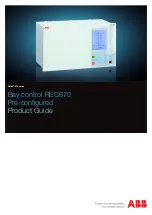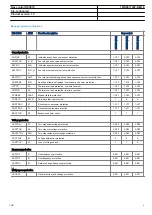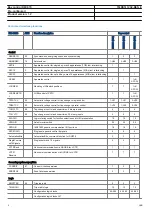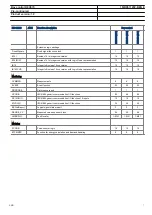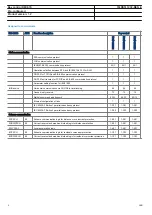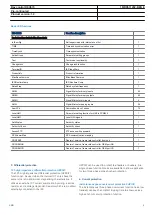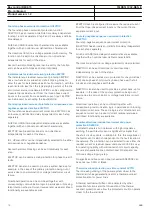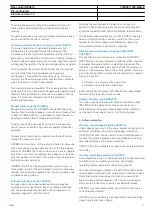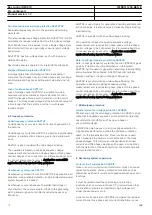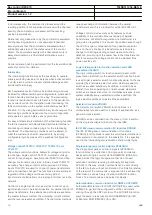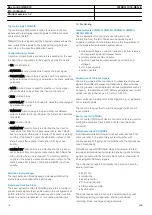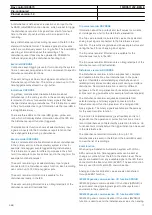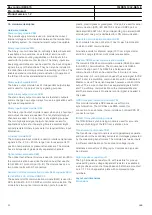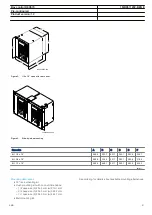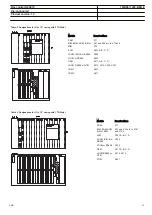
The three-phase current measuring protection has an I
2
t
characteristic with settable time constant and a thermal
memory..
An alarm level gives early warning to allow operators to take
action well before the line is tripped.
Thermal overload protection, two time constant TRPTTR
If a power transformer or generator reaches very high
temperatures the equipment might be damaged. The
insulation within the transformer/generator will have forced
ageing. As a consequence of this the risk of internal phase-to-
phase or phase-to-earth faults will increase. High temperature
will degrade the quality of the transformer/generator insulation.
The thermal overload protection estimates the internal heat
content of the transformer/generator (temperature)
continuously. This estimation is made by using a thermal
model of the transformer/generator with two time constants,
which is based on current measurement.
Two warning levels are available. This enables actions in the
power system to be done before dangerous temperatures are
reached. If the temperature continues to increase to the trip
value, the protection initiates a trip of the protected
transformer/generator.
Breaker failure protection CCRBRF
Breaker failure protection (CCRBRF) ensures fast back-up
tripping of surrounding breakers in case the own breaker fails
to open. CCRBRF can be current based, contact based, or
an adaptive combination of these two conditions.
Current check with extremely short reset time is used as
check criterion to achieve high security against inadvertent
operation.
Contact check criteria can be used where the fault current
through the breaker is small.
CCRBRF can be single- or three-phase initiated to allow use
with single phase tripping applications. For the three-phase
version of CCRBRF the current criteria can be set to operate
only if two out of four for example, two phases or one phase
plus the residual current start. This gives a higher security to
the back-up trip command.
CCRBRF function can be programmed to give a single- or
three-phase re-trip of the own breaker to avoid unnecessary
tripping of surrounding breakers at an incorrect initiation due
to mistakes during testing.
Pole discordance protection CCRPLD
An open phase can cause negative and zero sequence
currents which cause thermal stress on rotating machines
and can cause unwanted operation of zero sequence or
negative sequence current functions.
Normally the own breaker is tripped to correct such a
situation. If the situation persists the surrounding breakers
should be tripped to clear the unsymmetrical load situation.
The Polediscordance protection function CCRPLD operates
based on information from auxiliary contacts of the circuit
breaker for the three phases with additional criteria from
unsymmetrical phase currents when required.
Directional over/underpower protection GOPPDOP/
GUPPDUP
The directional over-/under-power protection GOPPDOP/
GUPPDUP can be used wherever a high/low active, reactive
or apparent power protection or alarming is required. The
functions can alternatively be used to check the direction of
active or reactive power flow in the power system. There are
a number of applications where such functionality is needed.
Some of them are:
• detection of reversed active power flow
• detection of high reactive power flow
Each function has two steps with definite time delay. Reset
times for both steps can be set as well.
Broken conductor check BRCPTOC
The main purpose of the function Broken conductor check
(BRCPTOC) is the detection of broken conductors on
protected power lines and cables (series faults). Detection
can be used to give alarm only or trip the line breaker.
5. Voltage protection
Two step undervoltage protection UV2PTUV
Undervoltages can occur in the power system during faults or
abnormal conditions. Two step undervoltage protection
(UV2PTUV) function can be used to open circuit breakers to
prepare for system restoration at power outages or as long-
time delayed back-up to primary protection.
UV2PTUV has two voltage steps, each with inverse or definite
time delay.
Two step overvoltage protection OV2PTOV
Overvoltages may occur in the power system during abnormal
conditions such as sudden power loss, tap changer
regulating failures, open line ends on long lines etc.
Two step overvoltage protection (OV2PTOV) function can be
used to detect open line ends, normally then combined with a
directional reactive over-power function to supervise the
system voltage. When triggered, the function will cause an
alarm, switch in reactors, or switch out capacitor banks.
OV2PTOV has two voltage steps, each of them with inverse
or definite time delayed.
OV2PTOV has an extremely high reset ratio to allow settings
close to system service voltage.
Bay control REC670
1MRK511232-BEN E
Pre-configured
Product version: 1.2
ABB
11

